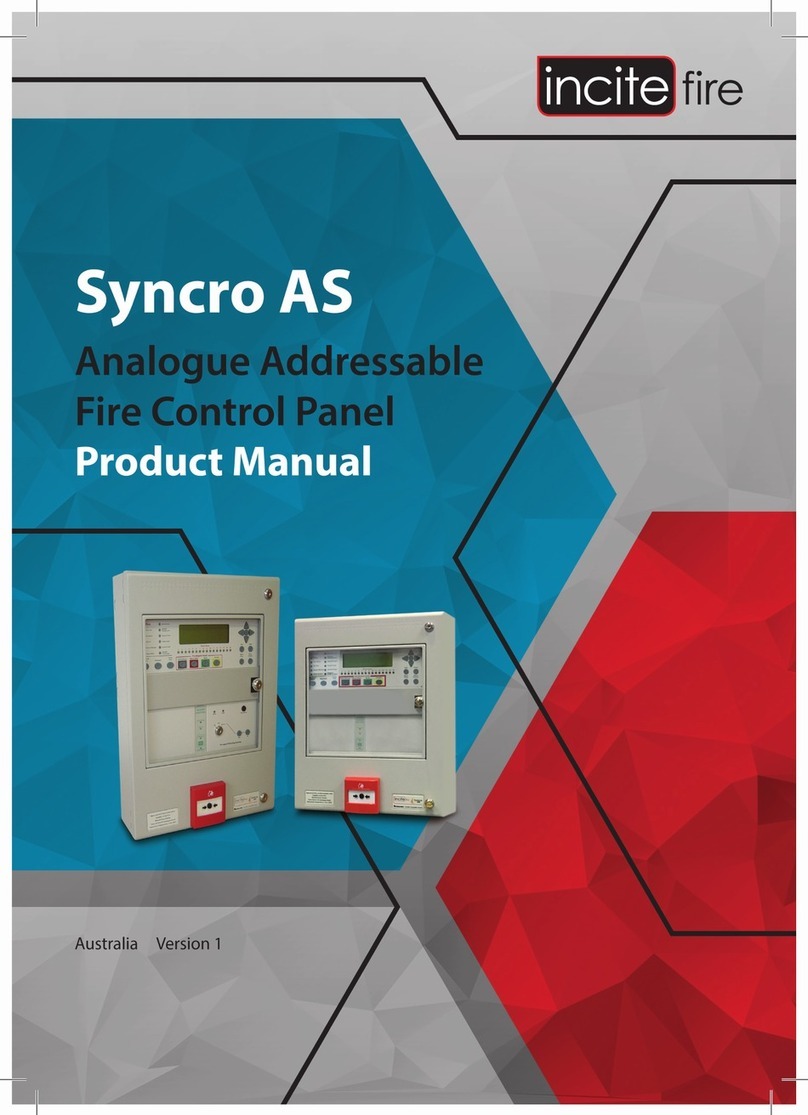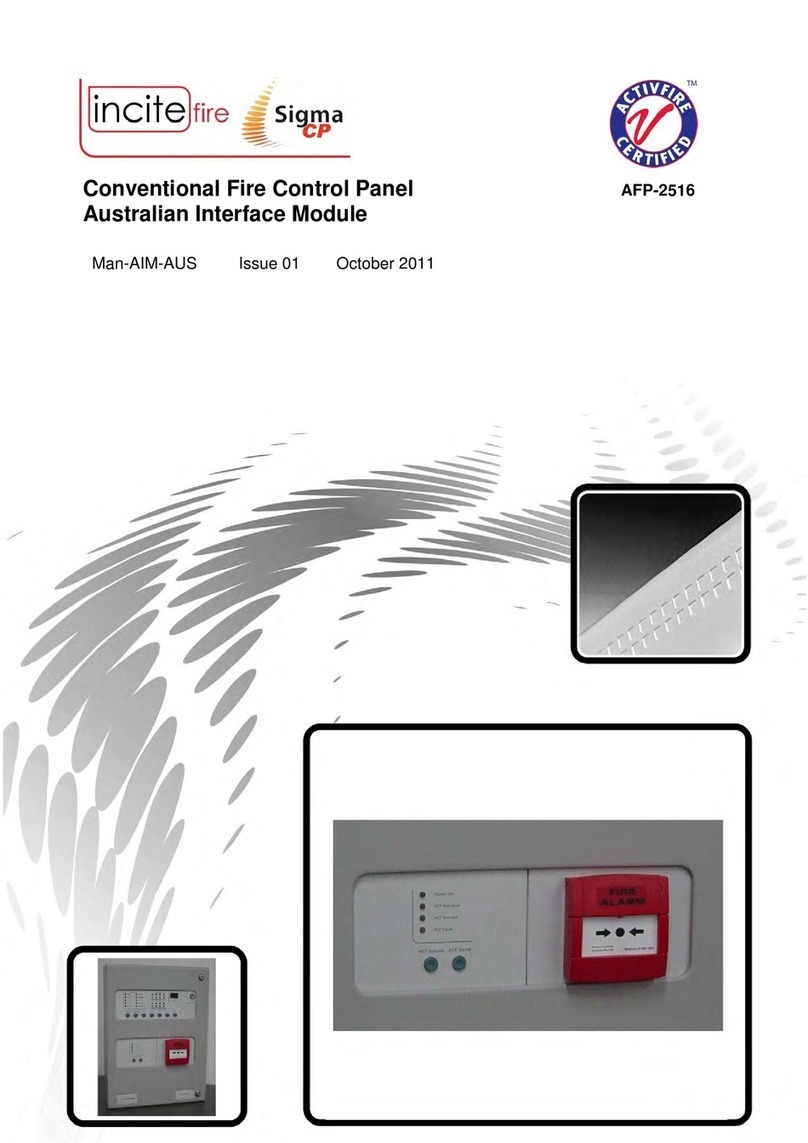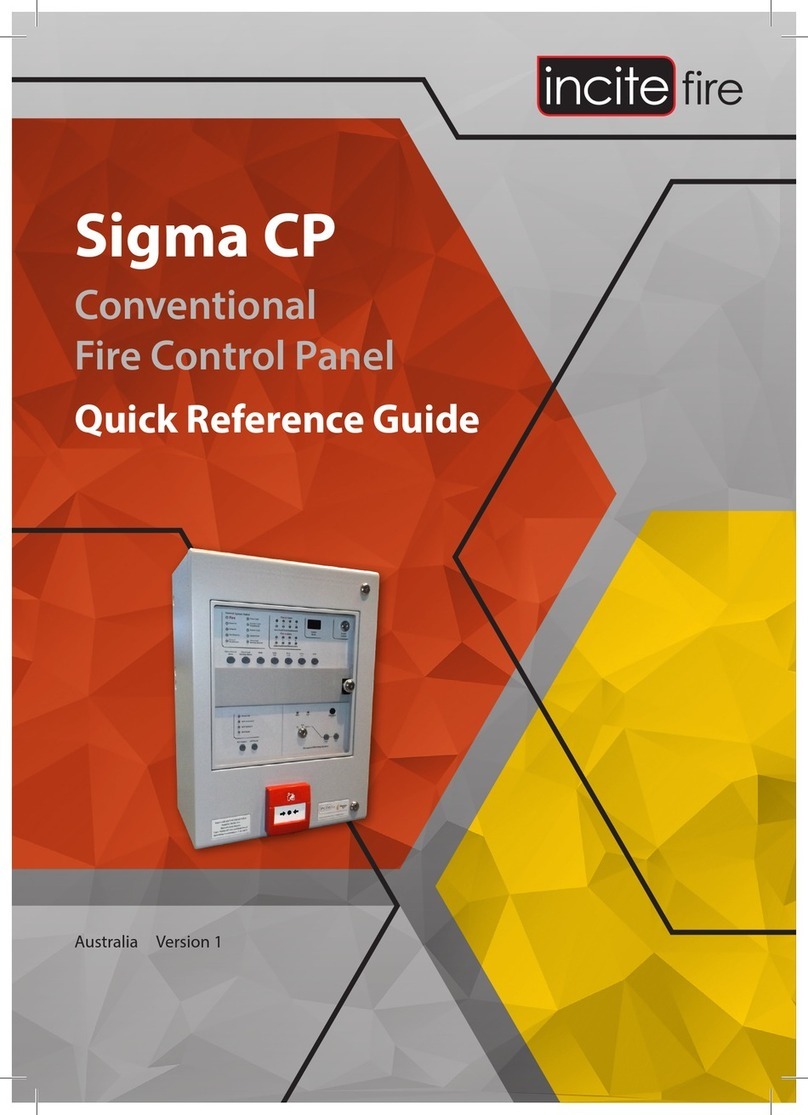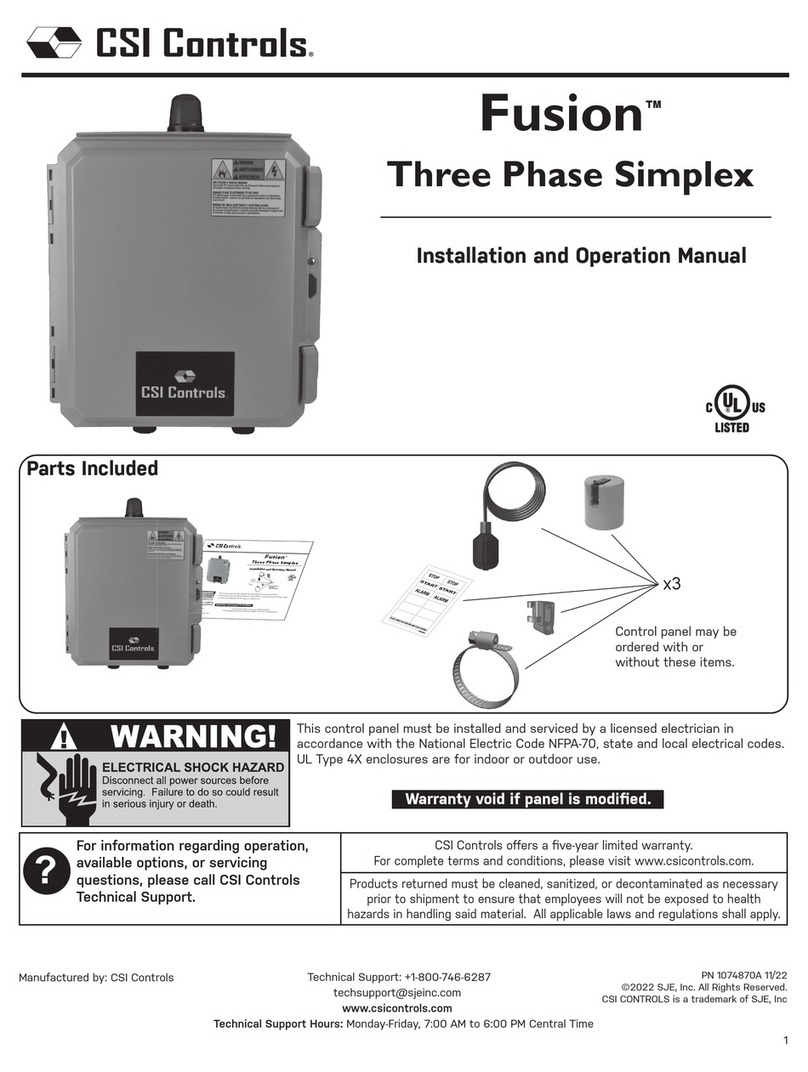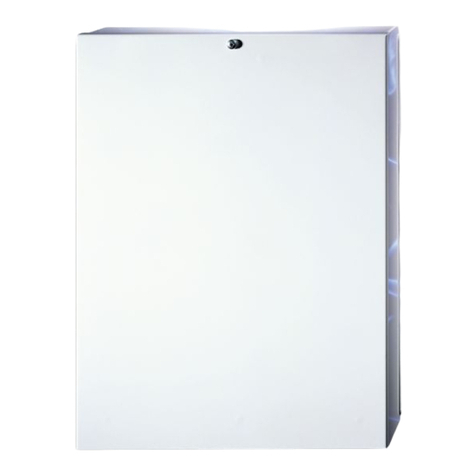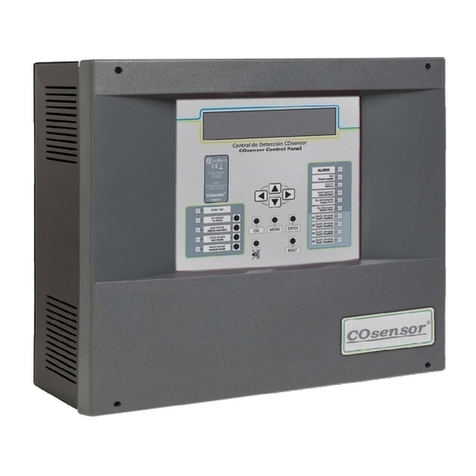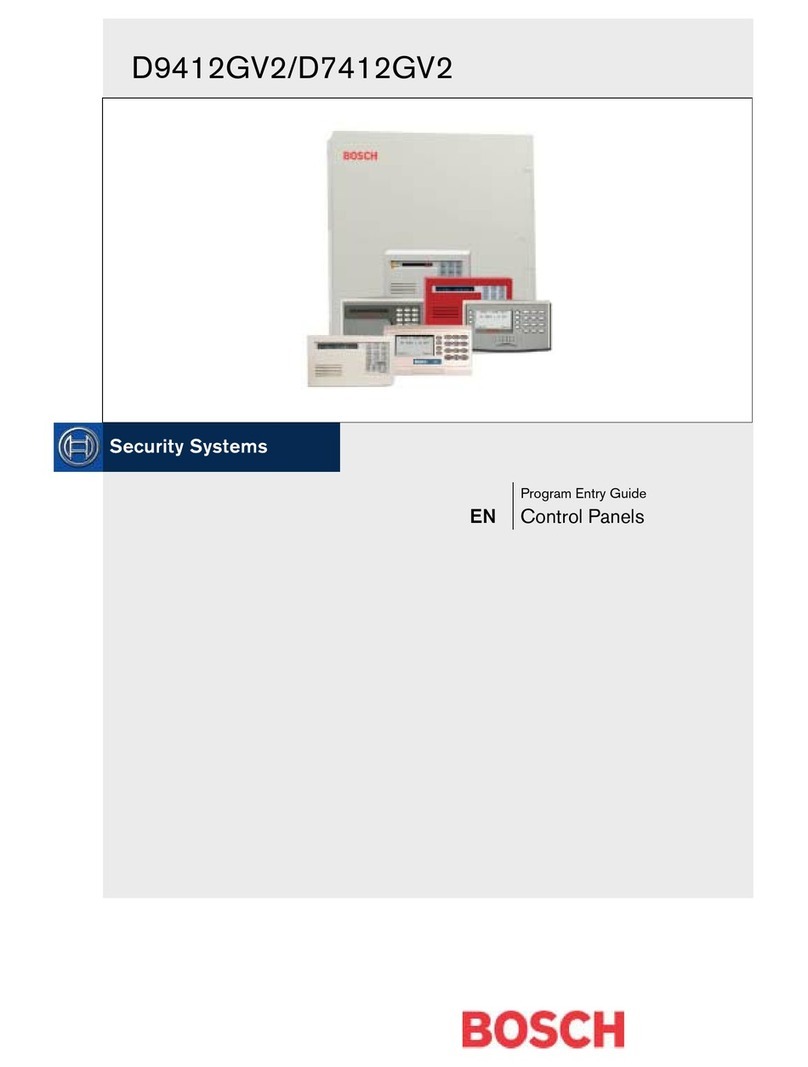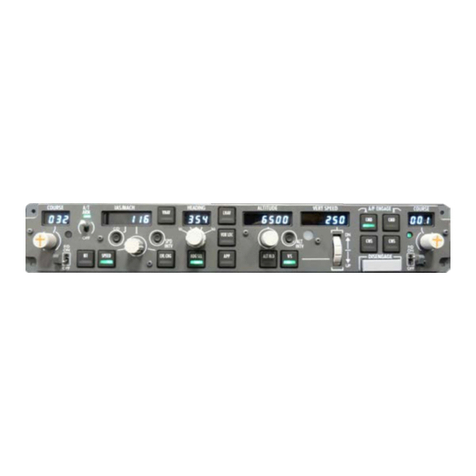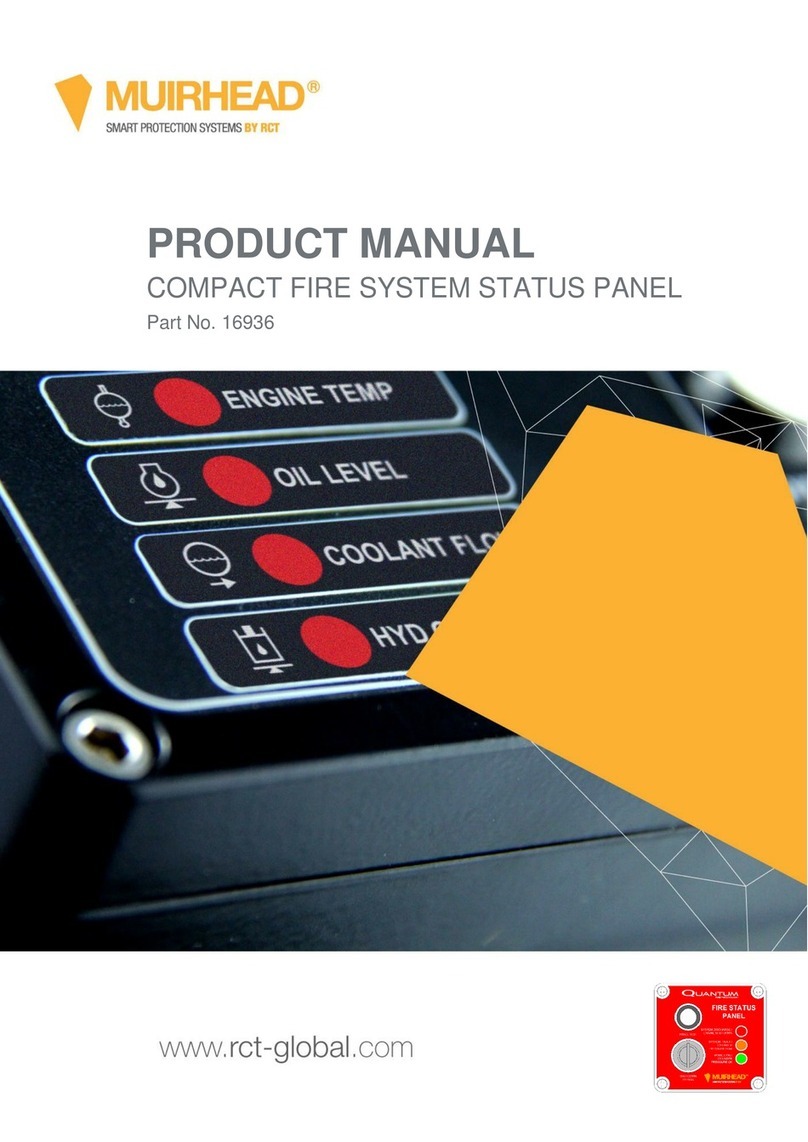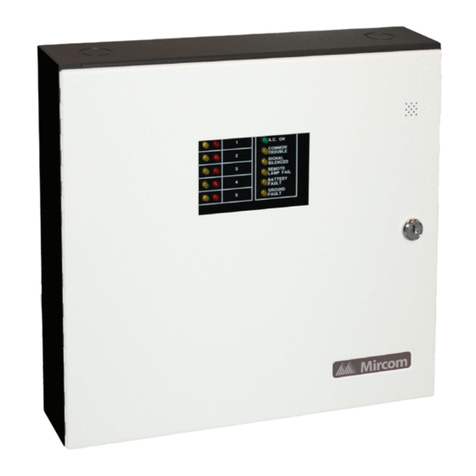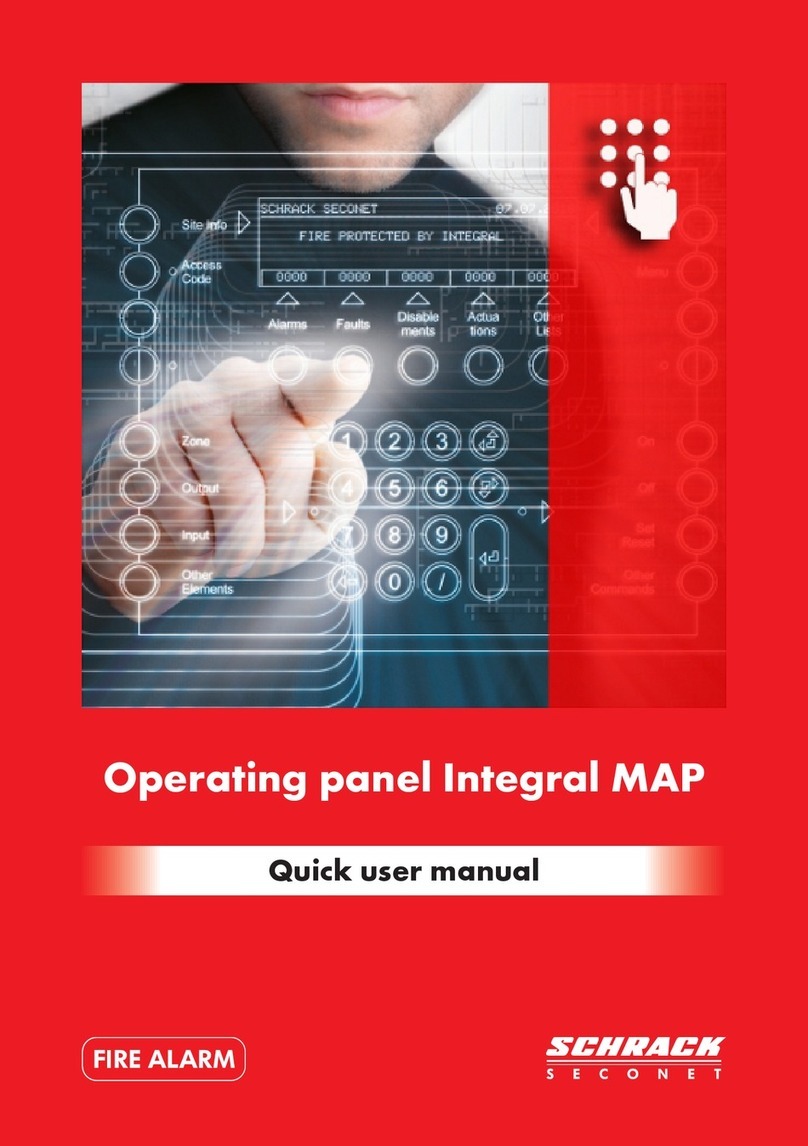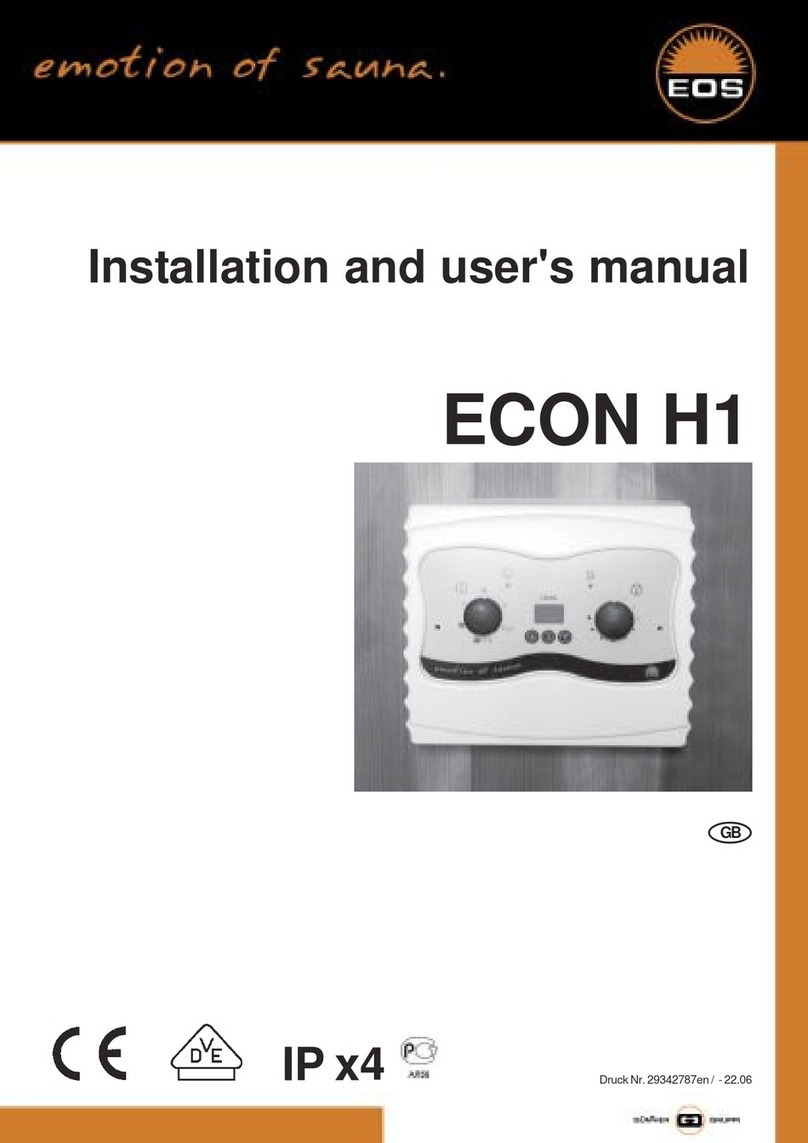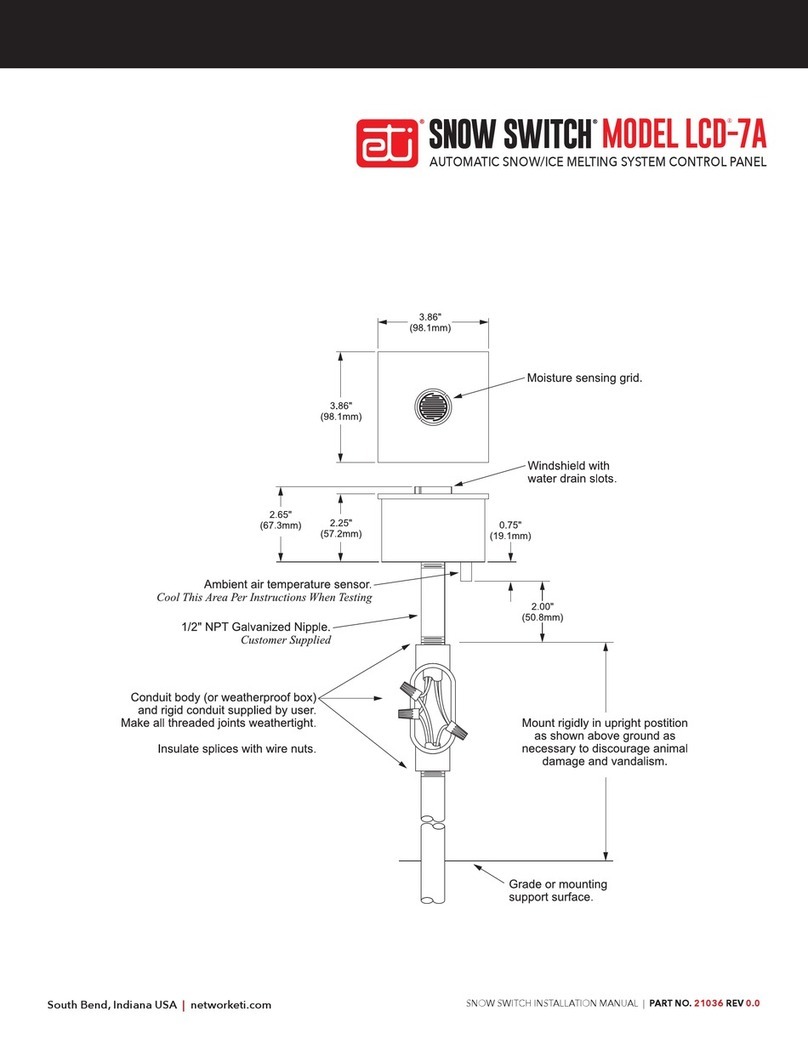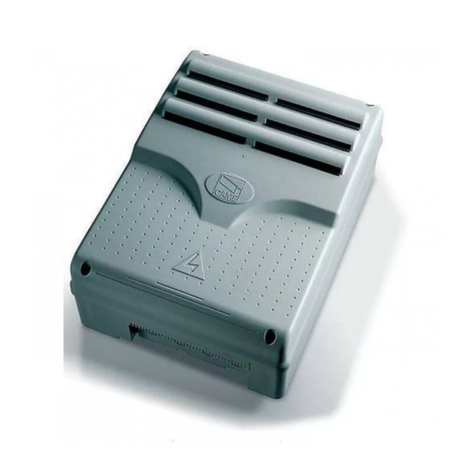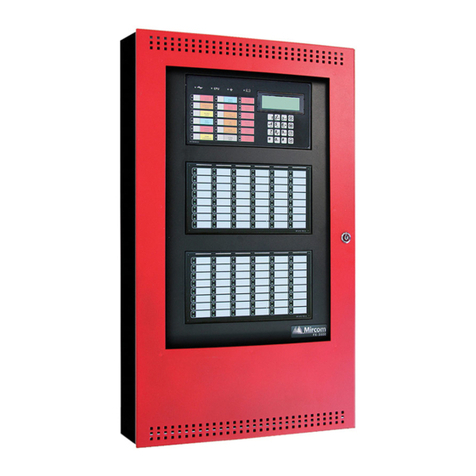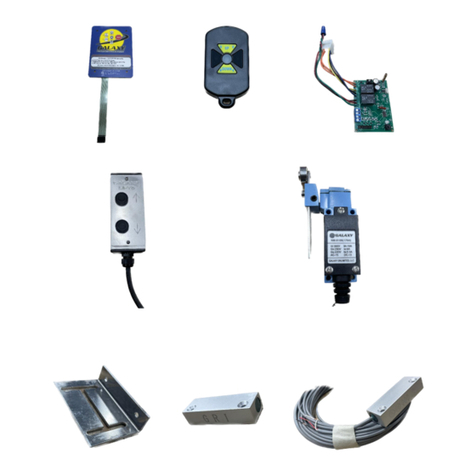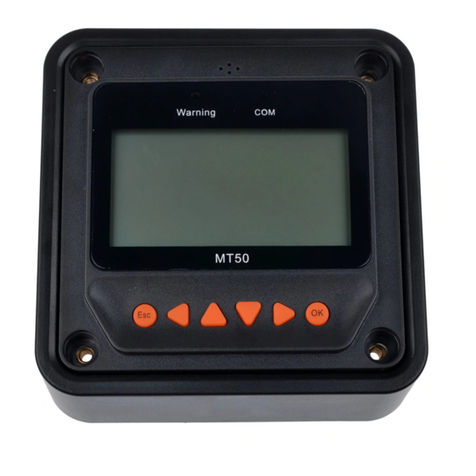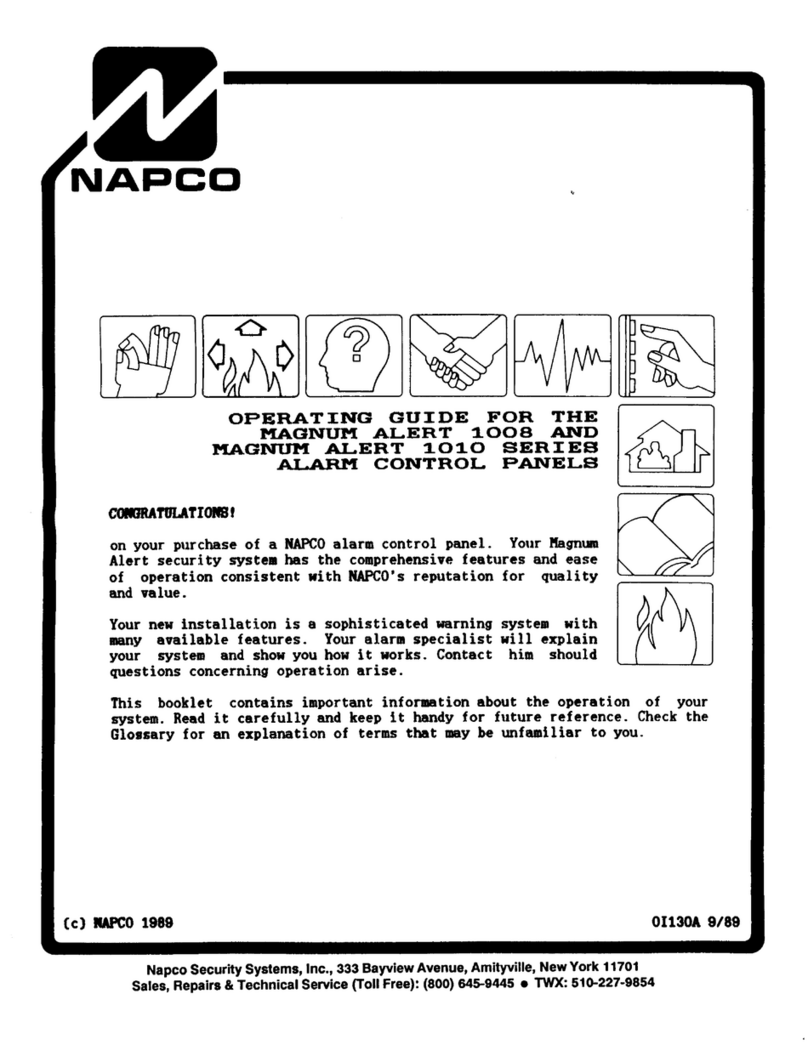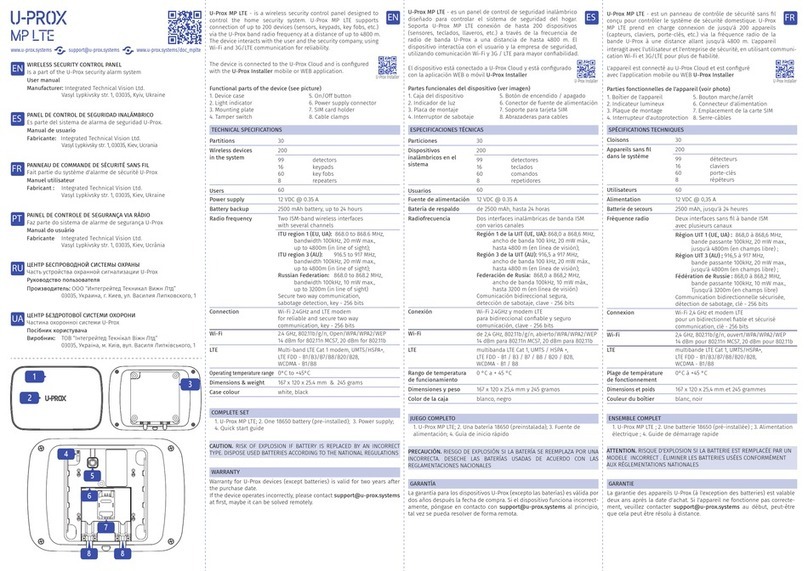Incite Fire Sigma CP User manual

SIGMA-CP Issue 1 November 2011
Conventional Fire Control Panel AFP-2516
Operation and Maintenance Manual

Man-1078_Sigma_CP_AUS_12
Page 2 of 29
Index Page
1 Warning ......................................................................................................................... 4
2 Introduction .................................................................................................................... 5
3 Safety and Mounting ........................................................................................................ 5
3.1 Safety .................................................................................................................................... 5
3.2 Mounting ................................................................................................................................ 6
4 Technical specification ..................................................................................................... 7
6 sing intrinsically safe barriers.......................................................................................... 9
7 Control panel fascia ....................................................................................................... 10
8 Connecting to the circuit board ....................................................................................... 11
9 Software revision number .............................................................................................. 11
10 Detection zone wiring .................................................................................................... 12
11 Sounder circuit wiring .................................................................................................... 13
12 Connection to remote control terminals ........................................................................... 13
13 Aux 24V DC supply ........................................................................................................ 14
14 Connection to relay contacts........................................................................................... 14
15 Connection to Accessory modules ................................................................................... 14
16 Panel operation ............................................................................................................. 15
16.1 Normal condition ................................................................................................................... 15
16.2 Fire condition ........................................................................................................................ 15
16.3 Silence/Sound Alarms ............................................................................................................ 15
16.4 Reset ................................................................................................................................... 15
16.5 one fault ............................................................................................................................. 15
16.6 Sounder fault ........................................................................................................................ 15
16.7 Power fault ........................................................................................................................... 15
16.8 System fault ......................................................................................................................... 15
16.9 Lamp test ............................................................................................................................. 15
16.10 Buzzer Silence ....................................................................................................................... 15
16.11 Disablements ........................................................................................................................ 16
16.12 Disable zones ........................................................................................................................ 16
16.13 Disable sounders ................................................................................................................... 16
16.14 Activate delays ...................................................................................................................... 16
16.15 Disable fault contact .............................................................................................................. 16
16.16 Test mode ............................................................................................................................ 16
17 Configuration options ..................................................................................................... 16
18 Watchdog reset switch ................................................................................................... 19

Man-1078_Sigma_CP_AUS_12
Page 3 of 29
19 Processor reset switch ................................................................................................... 20
20 Internal indications – troubleshooting .............................................................................. 20
20.1 Mains fail .............................................................................................................................. 20
20.2 Batt fail ................................................................................................................................ 20
20.3 CPU fault .............................................................................................................................. 20
20.4 Aux 24V fault ........................................................................................................................ 20
20.5 Batt low ................................................................................................................................ 20
20.6 Earth fault ............................................................................................................................ 20
20.7 Sys fuse fault ........................................................................................................................ 20
20.8 S1 fault and S2 fault .............................................................................................................. 20
20.9 Comms fault ......................................................................................................................... 21
21 AIM – Australian Interface Module .................................................................................. 21
21.1 ACF – Ancillary Control Function............................................................................................. 22
21.1.1 Outputs.................................................................................................................................................22
21.1.2 Configuration:......................................................................................................................................22
21.1.3 Controls – only available at Level 2.....................................................................................................22
21.2 Door Holder Output ............................................................................................................... 23
21.3 ASE Outputs (Alarm Signalling Equipment) ............................................................................. 23
21.4 Installation ........................................................................................................................... 23
21.5 Configuration. ....................................................................................................................... 23
22 Power supply ................................................................................................................ 24
23 Maintenance ................................................................................................................. 25
24 Zone designation label ................................................................................................... 25
25 Record of Configuration ................................................................................................. 26

Man-1078_Sigma_CP_AUS_12
Page 4 of 29
1Warning
Sounders can only be used on detection circuits if Hochiki YBO-R/6PA detector bases are
used.
To disable sounders on detector all lines, ensure that configuration mode 25 is not set.
To disable sounders on individual detector circuits, set configuration mode 25 and disable
individual circuits through the setting of C1 to C8.See Section 17Table 8.
DETECTOR BASES WILL BE DAMAGED IF THE INCORRECT
MODEL IS USED ON CIRCUITS WHICH HAVE SOUNDERS
ENABLED.
DAMAGE DUE TO INCORRECT CONFIGURATION WILL NOT
COVERED UNDER WARRANTY.

Man-1078_Sigma_CP_AUS_12
Page 5 of 29
2Introduction
The SIGMA CP conventional fire alarm control panel is designed to comply with AS724 -2 and AS724 -4 Fire
Detection and Fire Alarm systems - Control and Indicating Equipment.
The control panel has an integral, mains powered battery charger and power supply designed in accordance
with the requirements of AS724 -4.
In addition to the requirements of AS724 -2 the control panel has the following facilities:
Test condition to allow the automatic resetting of zones in alarm for testing purposes. AS724 -2
Section 11 option with requirements.
Delay of the actioning of fire alarm devices (sounders) so that an alarm may be verified before a
premises is evacuated. AS724 -2 Section 7.11 option with requirements.
Fire alarm devices to enable an audible warning to be sounded throughout a premises upon the
detection of a fire condition or the operation of a manual call point. AS724 -2 Section 7.8 option with
requirements.
Voltage free relay contacts for fire and local fire which operate upon fire condition. These are to be
used for local control and signalling.
3Safety and Mounting
3.1 Safety
Suppliers of articles for use at work are required to ensure as reasonably as is practical that the article will
be safe and without risk to health when properly used.
An article is not regarded as properly used if it is used ‘without regard to any relevant information or advice’
relating to its use made available by the supplier.
This product should be installed, commissioned and maintained by trained service personnel in accordance
with the following:
(i) Local regulations for electrical equipment in buildings
(ii) Codes of practice
(iii) Statutory requirements
(iv) Any instructions specifically advised by the manufacturer
You are therefore requested to take such steps as are necessary to ensure that you make any appropriate
information about this product available to anyone concerned with its use.
This equipment is designed to be operated from 23 V 5 Hz mains supplies and is of class 1 construction. As
such it must be connected to a protective earthing conductor in the fixed wiring of the installation and a
readily accessible double pole disconnect device which disconnects live and neutral simultaneously shall be
incorporated in the fixed wiring.
Failure to ensure that all conductive accessible parts of this equipment are adequately bonded
to the protective earth will render the equipment unsafe.
This control panel is designed for indoor use only and at temperatures between -50C (+/- 3) and +5 0C (+/-
2) and with a maximum relative humidity of 95%.
The IP rating for the enclosure is IP3 .
Operation outside of these limits may render the equipment unsafe.

Man-1078_Sigma_CP_AUS_12
Page 6 of 29
3.2 Mounting
The control panel should be mounted on a dry, flat surface, at eye height to the display and in a level
position such that the enclosure is not distorted.
Screws or bolts of a minimum of 5mm diameter must be used to mount the enclosure in all four mounting
points.
It should be positioned in an accessible position as agreed with the end user.
Suitable fixings should be used at all fixing points such that the control panel is securely mounted and is not
liable to move once fixed.
The control panel should not be mounted in another enclosure or near sources of excessive heat.
Cables should be connected using suitable cable glands fitted to the knockouts provided. If additional cable
entry points are required, all swarf and debris caused by drilling of additional cable entries must be cleared
before power is applied to the panel.

Man-1078_Sigma_CP_AUS_12
Page 7 of 29
4Technical specification
Table 1
Electrical Specifications
Mains supply
230V AC +10%
-
15% (100 Watts maximum)
Mains supply fuse
1.6Amp ( 1.6A L250V)
Replace only with similar type
Power supply rating
3 Amps total including battery charge 28V +/ 2V
Maximum ripple current
1.5 Volts
Output voltage
18
.5 to 29
V DC
+/
-
2%
Imax a
40
0 milliamps
Imax b
2.3
Amps
Imin
0.065A
Battery type (Yuasa NP)
Two 12 Volt sealed lead acid (7Ah maximum)
See
Table
2
for
capacities
Battery charge voltage
27.6VDC nominal (temperature compensated)
See
Table
3
Battery charge current
0.7A maximum
Battery lead fuse
20mm, 3.15A glass
Replace only with the same type
Battery high impedance warning
(Rimax)
1.
3
5 ohms
max
Low battery voltage indication
21V +/
-
2%
Low battery shut off voltage
18.5V +/
-
2%
Maximum current draw from batteries
3 Amps
With main power source disconnected
R0V output
used at with electronic fuse
Dedicated sounder outputs
24V used at 500mA with electronic fuse
1.6 Amp total load over
all
circuits
Zonal sounder outputs
24V
used at 500mA with electronic fuse
1.6 Amp total load
over
all
circuits
ault relay contact rating
30VDC 1A Amp maximum for each
Ma imum ratings not to be e ceeded
ire relay contact rating
30VDC 1A Amp maximum for each
Ma imum ratings not to be e ceede
d
Local fire relay contact rating
30VDC 1A Amp maximum for each
Ma imum ratings not to be e ceeded
Zone quiescent current
1.6mA maximum
See
Table
4
for detector types
Terminal capacity
0.5mm
2
to 2.5mm
2
solid or stranded wire
Number of detectors per zone
> 20
Dependent on type
Number of sounders per circuit
Dependent on type and curr
ent consumption
See
Table
6
for sounder types
Detection circuit end of line
6K8 5% ½ Watt resistor
Supplied in terminals
Sounder circuit end of line
10K 5% ¼ Watt resistor
Supplied in terminals
No
.
of detection circuits
(see
Table
2
for number of zones for each model)
Dependent on model
No
.
of
sounder outputs
2 (plus one per zone on T models)
SIL, AL, LT, RST inputs
Switched
-
ve, max resistance 100 Ohms
Zone normal threshold
8K ohm TO 1K ohm
Detector alarm threshold
999 ohms to 400 ohms
Call point alarm threshold
399 ohms to 100 ohms
Short circuit threshold
99 ohms to 0 ohms
Head removal condition
15.5 to 17.5 volts
Zener clamp detector base to be used
Cabling
To Australian Standards (
maximum capacitance 1u
maximum inductance 1 millihenry)
Metal cable glands must be used
Table 2
Standby battery capacity required for fully loaded system
Panel model
24 hours
standby
48 hours standby
72 hours
standby
Standby current
Max panel alarm
current
T11080
M3
(8 Zones)
3.75Ah
5.95Ah
8.2Ah
0.093A
0.63A
Table 3
Battery char e volta e versus temperature
Temperature
0C
Battery charge voltage
0
29 2
10
28 56
20
27 99
30
27 55
40
27 13

Man-1078_Sigma_CP_AUS_12
Page 8 of 29
Table 4
Compatible Detectors
Model Type Manufacturer Maximum Number per zone
SLV-AS OPT CAL HOCH K 40
DCD-A HEAT HOCH K 40
DCD-C HEAT HOCH K 35
DFJ-60B HEAT HOCH K 40
DFJ-90D HEAT HOCH K 35
DFG-60BLKJ HEAT HOCH K 40
DRD-AS FLAME HOCH K 25
SPC-AS BEAM HOCH K 6
Table 5
Compatible detector bases and call points
Model Type Manufacturer Comments
YBN-R/4C PLA N BASE HOCH K
YBO-R/4A LED BASE HOCH K
YBO-R/6PA LED BASE HOCH K
MUS1A-R470SG-01 CALL PO NT KAC
MUS1A-R470SF-01 CALL PO NT KAC
Table 6
Compatible sounders
Model Type Manufacturer Comments
ROSHN FULLEON
SQUASHN FULLEON
SQUASHN M CRO FULLEON
Table 7
Compatible I.S. barriers
Note: To use detectors and sounders within an intrinsically safe area, the detectors and sounders must be of
an intrinsically safe type and approved for use within the risk category.
Model
Type
Manufac
turer
MTL5061
DETECTION ZONE GALVANIC ISOLATOR
MTL
MTL778ac
SOUNDER CIRCUITS SI AND S2 ONLY
MTL

Man-1078_Sigma_CP_AUS_12
Page 9 of 29
6Using intrinsically safe arriers
SIGMA CP control panels support the use of I.S. barriers for connecting to equipment in hazardous areas.
Only certified detectors, call points and sounders may be used in hazardous areas and these
must be connected to the control panel via a compatible I.S. barrier as listed in Table 7.
Connection of the I.S. barrier changes the characteristics of the detection circuit, therefore zones that have
I.S. barriers connected, must be adjusted to work with them.
Programmable options C61 to C68 allow each zone to operate with I.S. barriers.
The amount of detectors and call points that can be connected to a zone is limited by the I.S. approval
system diagram which should be supplied by the detector manufacturer. The power rating of the end of line
resistor will be dependent upon the Zone classification rating (Gas class) this will be specified on the system
diagram.
Figure 1. Detection zone wiring through an MTL5061 I.S .barrier
+ -
SOUNDER
OUTPUT
I.S .
POLARISED
SOUNDER
10K END OF LINE RESISTOR
MTL778ac
MAXIMUM OF TWO SOUNDERS PER SOUNDER CIRCUIT
I.S .
EARTH
POWER WILL DEPEND UPON
I.S. ZONE CLASSIFICATION
HAZARDOUS AREASAFE AREA
+
IN +
OUT
-
IN
-
OUT
I.S .
POLARISED
SOUNDER
+
IN +
OUT
-
IN
-
OUT
Figure 2. Sounder circuit wiring through an MTL778ac I.S. barrier
+
IN
+
OUT
-
IN
-
OUT
I.S. DETECTOR
I.S . CALL POINT
MTL5061
6K8 END OF
LINE RESISTOR
SAFE AREA HAZARDOUS AREA
POWER RATING WILL
DEPEND UPON I.S. ZONE
CLASSIFICATION
MAXIMUM NUMBER OF DEVICES ON ZONE
SPECIFIED IN SYSTEM DIAGRAM

Man-1078_Sigma_CP_AUS_12
Page 10 of 29
7Control panel fascia
In addition to the mandatory controls and indications required by the AS724 -2 standard, two seven-
segment LED displays and MODE, SELECT and ENTER buttons are provided to allow easy entry and storage
of codes to configure the control panel to suit the requirements of the installation.
Openin the fascia
The fascia of the control panel is held in place by a screw on the right hand side. Undo the screw and lift
the plate from the right hand side.
Opening the fascia allows more room when mounting the cabinet and fitting cables.

Man-1078_Sigma_CP_AUS_12
Page 11 of 29
8Connecting to the circuit oard
All connections for field wiring are to a single row of terminals along the top of the circuit board.
The connections for the power cables are to a pluggable terminal block which may be pulled off of the board
to remove power from the PCB assembly. Remove this pluggable terminal only with Mains Power OFF.
Cabling must comply with the relevant Australian Standards. The resistance of any core of any cable must
not exceed 25 ohms.
Wiring should enter the enclosure at the top of the panel using the knockouts provided and be formed tidily
to the appropriate terminals leaving only enough wire to ensure that there is no strain on the PCB.
Terminals are capable of accepting wires of up to 2.5mm2.
Terminal designations
Wiring must not go across the front of the circuit board plate or between the plate and the circuit board.
If cable entries need to be in positions other than at the knockouts provided, wiring must be fed behind and
well away from the surface of the circuit board.
The space at the bottom of the enclosure is largely occupied by the standby batteries so this must be borne
in mind when considering cable entries.
9Software revision num er
New features may be added to Sigma CP fire control panels from
time to time and when this is done the operating software of the
unit is updated. The software revision can be located on the main
processor by removing the plate holding the PCB from the
enclosure and turning it over. The software version will have a
number such as “Sig27.hex” and it is this number which will
determine which features the panel has installed and its
compatibility with Sigma CP ancillary board, sounders boards,
repeaters etc.
CORRECT
INCORRECT INCORRECT
SW1
SW2
SW4
SERIAL NUMBER
++++
+
+
+
+
+
D 1008 ISSUE06
C 1
R 1
R2
R3
R5R6
R7
R8
R9
C30
C31
R11
R12
R 13
R14
R15
R17R18
R19
R21
R51
R52 R53
R54
R55
R56
R57
R58
R60
R61
R62
R63
R64
R65R66
R67 R69
R71
R72
R73
R74
R78
R80
R81
R85
R86
R 87
R88
R90
R98 R99
R102
R103
R 104
R109
R110
R111
R112
C2C3C4C 5C7
C19
C 20C 21C 22C 23
C 27
C37C38C39 C40
C43
C44
C55
C 60 C 61
R113
R114
R116
R117
C96
C 33
R128
C 73C 74
C 75
C76
C 34
C 35 C 36
R 130
R 131
R 132
R 133
R 134
R 135
R137
R 129
C42
C 41
R89
R107
C81
R 126
C83
C94
C95
R118
R4A
R4B
R4C
R4D
R4E
R4F
R10A
R10B
R10C
R10D
R10E
R10F
R16A
R16B
R16C
R16D
R16E
R16F
R22A
C92
C 93C 97
C98
C99
C100
C101
C102
C103
R155
R156
R157
C104
C105
R158
C 106 C 107
C108
C109
D1D 2D 3
D4
D9
D10
D 11
D 12
D 13
D 14
D 15
D 16
D 22
D 23
Z 11
Z 14
D30
F1
F2
F4
F9
F10
F11
TR1
TR2
TR3
TR9
TR26
TR1 9
TR 24
TR 28TR 25
IC 4
IC5
IC10
IC1
IC 2
D 32D 33D 34
D 35
IC6
REG1
J 1
C 24
C 25
C 65C 66C 67C68
C 56
C 82
D41
D20
F12
C51
RL2
RL3 RL 1 RL9
RL 10
XTL1
LED3LED4LED5 LED6 LED7LED17 LED35
VR1
TH1
TR23
L1
T 3
REG3
FB5
FB6
FB7
FB8
FB1
FB2
FB3
FB4
FB9
FB10
R 70
R 75
R 76
X2X1
C45
VDR4 VDR3
VDR2
VDR1 FB20FB21
C128C127
LED8 LED11 LED15 LED12 LED10
LED16LED34LED9LED13LED14
C6
F3
R168
TR47
R167R166
Sig27.hex
Jason
SOFTWARE VERSION LABEL

Man-1078_Sigma_CP_AUS_12
Page 12 of 29
+
IN +
OUT
-
IN -
OUT
DETECTOR
CALL POINT
6K8 END OF
LINE RESISTOR
+
IN +
OUT
-
IN -
OUT
DETECTOR
CALL POINT
6K8 END OF
LINE RESISTOR
POLARISED
SOUNDER
IN OUT
+
IN +
OUT
_ _
NOTE: SOUNDER WIRED IN
REVERSE POLARITY
USE ONLY SA-WIRE BASES
ON “T” SERIES PANELS
Figure 4. – K Series detection zone wiring
Figure 5. - T series detection zone wiring
10 Detection zone wiring
The detection zones provide a nominal 24V DC to power compatible conventional detectors and call points.
The wiring is monitored for open and short circuit fault conditions. The 6K8 end of line monitoring resistors
that are factory fitted to the control panel’s terminals must be removed and placed across the last device
that is wired to the zone circuit.
Wiring can be conventional using standard detector bases (K series), or by the use of special detector bases
it is possible to wire the system such that detection devices and sounders are fitted to the same pair of
wires. (T series)
Detection zone circuits must be wired as a single, radial circuit with no spurs or T junctions to enable the
monitoring circuit to work correctly.
Polarised sounders may also be wired across the detection zone but in reverse polarity to that shown by the
zone terminals (see figure 5 below). Each zone can be configured individually as a 2-wire type zone or a
non 2-wire type zone using configuration options C1 to C8.

Man-1078_Sigma_CP_AUS_12
Page 13 of 29
11 Sounder circuit wiring
All sounders must be of the polarised type. If non-polarised sounders are used the control panel will
permanently show a fault condition.
Sounder circuits are monitored for open and short circuit faults by placing a 1 K end of line monitoring
resistor across the last device on the circuit.
Sounder circuits must be wired as a single, radial circuit with no spurs or T junctions to enable the
monitoring circuit to work correctly.
A maximum of 1.6 Amps is available for powering sounders with a maximum load of .41 Amps on any one
circuit.
12 Connection to remote control terminals
Some functions of the control panel can be controlled externally from the panel if required. Operation of
these inputs must be restricted by an access level 2 control as defined in AS724 -2.These are
abbreviated at the terminals block as follows:
a) Remote V supply – R V
b) Silence Alarm – SIL
c) Sound Alarm – AL
d) Fault – FLT
e) Reset – RST
To activate these inputs, the remote Volt (R V) supply must be connected to the input via a normally open
switch or contact and via a resistance of no greater than 1 ohms.
All of the remote control inputs are non-latching.
+
-
S1
Figure6.- Sounder circuit wiring
10K end of line
resistor
POLARISED
SOUNDER
IN OUT
+
IN
+
OUT
_ _
POLARISED
SOUNDER
IN OUT
+
IN
+
OUT
_ _

Man-1078_Sigma_CP_AUS_12
Page 14 of 29
13 Aux 24V DC supply
An auxiliary 24V DC supply is provided to enable local signalling or control of ancillary systems such as door
release controllers. The terminals for the Aux 24V supply are labelled Aux 24V and ROV. The ROV terminal
is the negative terminal and is the same terminal that should be used to switch the remote control terminals.
It is possible to make the ROV terminal pulsing so that by connecting it to the AL terminal via a remote volt-
free contact, it can be used to pulse the dedicated sounder circuits in response to a signal from another
system for example to give an alert. See programming code 24.
The supply is fitted with an electronic self-resetting fuse to protect the control panel’s 24V supply in the
event of a wiring fault.
Any standing load on the Aux 24V supply must be taken into account when calculating battery standby times
as standby time will be significantly affected by even modest standing loads. It is recommended that the
Aux24V output is not used to power standing loads and not used to supply loads of greater than 3
milliamps.
Where the Aux 24V supply is used to power electromechanical devices such as relays or door retainers it is
imperative that a suppression diode is fitted across the coil of the electromechanical device to prevent the
generation of high voltage transients back to the control panels power supply. The Aux 24V DC Supply is not
suitable for powering Sigma CP sounder boards, a separate power supply should be used for these.
14 Connection to relay contacts
Volt free changeover relay contacts are provided for local control and signalling if required. These contacts
are rated for switching signalling circuits only and the maximum ratings listed in Table 1should not be
exceeded under any circumstances.
Fault relay
The Fault Relay is normally energised and will de-energise upon any fault condition including total loss of power.
Local fire relay
The Local Fire Relay will energise upon activation of a fire condition on any of the zones or pressing of the
Sound Alarm Button on the front panel. The relay will remain activated until the alarm is silenced or the
panel is reset. This relay will not operate upon activation of the remote AL input or when a fire condition is
triggered on a zone that is in test mode.
Fire relay
The fire relay will energise upon activation of a fire condition on any of the zones. The relay will remain
activated until the control panel is reset. This relay will NOT operate upon activation of the remote AL input.
Individual zones can be configured not to operate the Fire relay by setting configuration options E1 to E8.
15 Connection to Accessory modules
Accessory modules include a Gas Module, Ancillary Relay Module, or an Australian Interface Module.
Accessory modules connect via a 2 core cable to the terminals marked RS485 + and – on the Sigma CP main
control panel PCB. Up to a total of 7 Accessory modules may be connected and each has terminals for the
incoming cables and outgoing cables. All except the last accessory module connected to the cable must
have the jumper links J2 removed.
The address of any accessory modules used within the system must have their address set using the DIP
switch on the module, ensuring that no two modules of the same type share the same address. NOTE: The
Australian Interface Module is fixed at Output unit address 7 and cannot be changed.
Apply power to main panel first and then all accessory modules. Turn ON the Enable Control keyswitch and
set the Write Enable switch to ON then briefly press the Processor Reset button on the main panel. Wait for
a few seconds and the main panel will show the addresses of the modules that were found on the display for
instance “r1” indicates that a module at address 1 has been found.
Turn the Write Enable switch OFF, then ON again and then press the Enter button to accept each module
that has been found. When all modules have been added, set the main panel Write Enable switch to OFF.
Press the Watchdog Reset switch on the main panel.
All modules are now configured and the main control panel will report a fault if any module, that has been
accepted, becomes faulty or goes off-line.

Man-1078_Sigma_CP_AUS_12
Page 15 of 29
16 Panel operation
16.1 Normal condition
Under normal conditions, control panels will have only the green, Power On LED lit.
16.2 Fire condition
Upon receipt of a fire condition by activation of a detector or call point, the Common Fire indicator will light
and the Fire in one indicators will flash at around 2Hz.
The Fire and Local Fire relays will also operate and signal any systems to which they are connected.
Any sounders connected to the sounder circuits will operate in common, zonal or 2-stage mode as selected
by configuration options 1 to 12 (see Table 8).
16.3 Silence/Sound Alarms
The Silence/Sound alarm button can only be operated at access level two which means that the Enable
Control keyswitch must be activated.
To silence the sounders, activate the Enable Control keyswitch and press the Silence/Sound Alarm button.
When the sounders have been silenced, the Zone Fire LEDs will change from flashing to a steady state.
Pressing the Silence/Sound Alarm whilst the control panel is in this silenced condition will cause the sounders
to operate again.
The sounders can be toggled on and off with the Silence/Sound Alarm button as required.
16.4 Reset
To reset the panel, activate the Enable Control keyswitch then press the Reset button.
16.5 one fault
Removal of a detector from its base or a fault on any of the zone wiring will cause the Fault LED and one
Fault LEDs to light indicating the zone in which the fault has occurred. Zone fault is non-latching and will
automatically reset once the fault has been rectified.
16.6 Sounder fault
A fault on the wiring to sounder circuits will cause the Fault and Sounder Fault LEDs to light indicating a fault
on the wiring to the sounder circuits. Sounder fault is non-latching and will automatically reset once the
fault has been rectified.
16.7 Power fault
Failure of the mains power, disconnection of the standby battery or high impedance in the charging circuit
will cause the Fault and Power Fault LEDs to light indicating an abnormality in the power supply to the
control panel. Power fault is non-latching and will automatically reset once the fault has been rectified.
16.8 System fault
The System Fault LED will light if the configuration memory has not been set or has become corrupt.
System fault is non-latching and will automatically reset once the configuration has been rectified.
16.9 Lamp test
All LED indicators can be tested at any time by pressing the Lamp Test button. The Enable Control
keyswitch does not need to be activated to test the indicators.
16.10 Buzzer Silence
The buzzer can be silenced at any time by pressing the Alarm/Fault Warning Silence button. The Enable
Control keyswitch does not need to be activated to silence the buzzer.

Man-1078_Sigma_CP_AUS_12
Page 16 of 29
16.11 Disablements
It is possible to disable parts of the system. This may be required if there are works going on in a building
which may cause the fire alarm system to operate in error.
16.12 Disable zones
To disable zones, the Enable Control keyswitch should be activated and the Mode button pressed until “d”
appears in the first of the two seven-segment LED displays. The Select button should then be pressed to
select the number of the zone which is to be disabled in the second of the two seven-segment displays.
Once the desired zone is displayed, the Enter button should be pressed to confirm the disablement.
The Disable LED will light and the one Fault LED will light for each disabled zone.
16.13 Disable sounders
To disable sounder outputs, press the Mode button to select “db” on the seven-segment display. Pressing
Enter will disable all sounders and cause the Disable and Sounder Fault LEDs to light.
16.14 Activate delays
To activate delays on zones as set in configuration options 31 to 48, press the Mode button until “Ad’
appears on the seven-segment LED display. When the Enter button is pressed any zones that are set as
delayed will have their alarm outputs delayed by the time set in configuration options to 9.
16.15 Disable fault contact
The fault relay can be disabled by selecting configuration option 22.
16.16 Test mode
Fire alarm systems must be tested regularly to ensure that they are functioning correctly. The Sigma CP
range of panels enable the system to be tested single handed by using a test mode. When in test mode,
activation of a fire alarm will be automatically reset after a few seconds to eliminate the need to return to
the control panel to reset after every activation.
Test mode is entered in a similar way to disablements. With the Enable Control keyswitch activated, press
the Mode button until “t” appears in the first of the seven-segment displays. Then press the Select button
until the required zone number appears. Pressing the Enter button will cause the Test and one Fault LEDs
to illuminate indicating the zones which are in test mode.
Disablements and zone tests are cleared by repeating the sequence that is used to select them, i.e. the "db"
function (for example) toggles between sounders disabled and sounders enabled.
17 Configuration options
The Sigma CP range of control panels has many configuration options which can be set at the time of
commissioning to suit the requirements of the installation. These options are normally set once and will
rarely need to change. The configuration options are only available at access level 3. To access level 3,
CAREFULLY slide the Write Enable switch (located behind the aperture in the panel plate) to the right
position using a small screwdriver or similar. When the panel is at access level 3, the buzzer will “pip” three
times every few seconds as an indication that it is at this access level.

Man-1078_Sigma_CP_AUS_12
Page 17 of 29
Configuration options are simple to enter using the codes in Table 8below. When the control panel is at
access level 3, the sub-text of the Mode and Select buttons is used to enter a number using tens (+1 ) and
units (+1).
When the required code number is displayed, pressing the Enter button will cause the dot on the units,
seven-segment display to flash. This indicates that a configuration option has been set.
To review which configuration options have been set previously, simply scroll through numbers 1 to 99, A1
to A8, C1 to C8 and E1 to E8 and those with a flashing dot indicate which options have been set.
DOT
FLASHING NO DOT
ZONE 1 I.S. BARRIER
OPTION SET
ZONE 1 I.S. BARRIER
OPTION NOT SET
Figure 9
–
E ample display showing option set and not set.

Man-1078_Sigma_CP_AUS_12
Page 18 of 29
Table 8
Confi uration Codes
CODE
FUNCTION
COMMENTS
00
SOUNDER DELAY TIME = 30 SECONDS
Sets the time delay before sounders
operate in combination with
configuration codes 31 to 48 and access level 2 function AD.
01
SOUNDER DELAY TIME = 1 MINUTE
02
SOUNDER DELAY TIME = 2 MINUTES
03
SOUNDER DELAY TIME = 3 MINUTES
04
SOUNDER DELAY TIME = 4 MINUTES
05
SOUNDER DELAY TIME
= 5 MINUTES
06
SOUNDER DELAY TIME = 6 MINUTES
07
SOUNDER DELAY TIME = 7 MINUTES
08
SOUNDER DELAY TIME = 8 MINUTES
09
SOUNDER DELAY TIME = 9 MINUTES
10
COMMON ALARM MODE (default)
All sounders operate upon any fire condition
11
TWO
-
STAGE ALARM
MODE
Continuous sounders in activated zone, pulsing elsewhere
12
ZONED ALARM MODE
Only sounders connected to zone in alarm operate
21*
DISABLE IRE BUZZER
Buzzer will not operate on fire condition
22*
DISABLE AULT OUTPUT
ault relay will not
operate except upon total power failure
23
DISABLE EARTH AULT MONITORING
Connection of fire alarm wiring will not announce a fault
24
PULSED REMOTE CONTROL OUTPUT
Aux 24V supply pulses 1 sec on/1 sec off
25
ENABLE SOUNDERS ON DETECTION CIRCUITS
Set as
default if panel is two wire “T” series (detectors and call
points on same cables)
26
DISABLE IRE OUTPUT
ire relay will not operate upon any alarm
27
REMOVE AUX 24 UPON PANEL RESET
DO NOT SET
24V supply switches off for about 5 seconds when panel is
reset
28
I
NDICATE CALL POINT ACTIVATION
A
ctivation of a call point
with a 270R resistance fitted
is
indicated by a flashing zone indicator and “Pu” on the 7 segment
display. Activation of a detector will be indicated by a steady
zone indicator and nothing on the 7 segment display.
29
DO NOT RE
-
SOUND ALARMS ROM ANOTHER ZONE
Silenced sounders will not re
-
sound upon further zone
activations
31
ZONE 1 ALARM ROM DETECTOR DELAYED
Sounder outputs will be delayed by time set at options
0-9 when selected zone(s) triggered by detector only.
Note: Access level 2 function Ad must be set for this to take
effect.
32
ZONE 2 ALARM ROM DETECTOR DELAYED
33
ZONE 3 ALARM ROM DETECTOR DELAYED
34
ZONE 4 ALARM ROM DETECTOR DELAYED
35
ZONE 5 ALARM ROM DETECTOR
DELAYED
36
ZONE 6 ALARM ROM DETECTOR DELAYED
37
ZONE 7 ALARM ROM DETECTOR DELAYED
38
ZONE 8 ALARM ROM DETECTOR DELAYED
41
ZONE 1 ALARM ROM CALL POINT DELAYED
Sounder outputs will be delayed by time set at options
0-9 when selected zone(s) triggered by call point only.
Note access level 2 function Ad must be set for this to take
effect.
42
ZONE 2 ALARM ROM CALL POINT DELAYED
43
ZONE 3 ALARM ROM CALL POINT DELAYED
44
ZONE 4 ALARM ROM CALL POINT DELAYED
45
ZONE 5 ALARM ROM CALL
POINT DELAYED
46
ZONE 6 ALARM ROM CALL POINT DELAYED
47
ZONE 7 ALARM ROM CALL POINT DELAYED
48
ZONE 8 ALARM ROM CALL POINT DELAYED
51
COINCIDENCE ZONE 1
Zone contributes to ancillary board coincidence O/P
.
Any
number of zones can be selected to contribute.
52
COINCIDENCE ZONE 2
53
COINCIDENCE ZONE 3
54
COINCIDENCE ZONE 4
55
COINCIDENCE ZONE 5
56
COINCIDENCE ZONE 6
57
COINCIDENCE ZONE 7
58
COINCIDENCE ZONE 8
61
CON IGURE Z1 OR I.S BARRIER
Detection threshold changed
for use with IS barrier
62
CON IGURE Z2 OR I.S BARRIER
63
CON IGURE Z3 OR I.S BARRIER
64
CON IGURE Z4 OR I.S BARRIER
65
CON IGURE Z5 OR I.S BARRIER
66
CON IGURE Z6 OR I.S BARRIER
67
CON IGURE Z7 OR I.S BARRIER
68
CON IGURE Z8 OR I.S
BARRIER

Man-1078_Sigma_CP_AUS_12
Page 19 of 29
CODE
FUNCTION
COMMENTS
71*
ZONE 1 SHORT CIRCUIT INDICATES ALARM
Changes the trigger threshold of
the zone
so that the control
panel can be used on older systems that had no short-circuit
monitoring.
72*
ZONE 2 SHORT CIRCUIT INDICATES ALARM
73*
ZONE 3 SHORT CIRCUIT INDICATES ALARM
74*
ZONE 4 SHORT CIRCUIT INDICATES ALARM
75*
ZONE 5 SHORT CIRCUIT INDICATES ALARM
76*
ZONE 6 SHORT CIRCUIT INDICATES ALARM
77*
ZONE 7 SHORT CIRCUIT INDICATES ALARM
78*
ZONE 8 SHORT CIRCUIT INDICATES ALARM
81*
ZONE 1 NON
-
LATCHING
Renders the zone self
-
resetting so
that it
can be used to receive
signals from other systems and will reset when the input is
removed.
Note: It can take up to 20 seconds for zone to reset itself when
sounders are operating
82*
ZONE 2 NON
-
LATCHING
83*
ZONE 3 NON
-
LATCHING
84*
ZONE 4 NON
-
LATCHING
85*
ZONE 5 NON
-
LATCHING
86*
ZONE 6 NON
-
LATCHING
87*
ZONE 7 NON
-
LATCHING
88*
ZONE 8 NON
-
LATCHING
91
ZONE 1 DOES NOT SOUND ALARMS
Prevents the zone from operating the
two common sounder
outputs.
92
ZONE 2 DOES NOT SOUND ALARMS
93
ZONE 3 DOES NOT SOUND ALARMS
94
ZONE 4 DOES NOT SOUND ALARMS
95
ZONE 5 DOES NOT SOUND ALARMS
96
ZONE 6 DOES NOT SOUND ALARMS
97
ZONE 7 DOES NOT SOUND ALARMS
98
ZONE 8 DOES NOT
SOUND ALARMS
A1*
ZONE 1 ANY ALARM DELAYED
Zone needs to be triggered for 30 seconds
continuously before
an alarm is generated.
A2*
ZONE 2 ANY ALARM DELAYED
A3*
ZONE 3 ANY ALARM DELAYED
A4*
ZONE 4 ANY ALARM DELAYED
A5*
ZONE 5 ANY ALARM
DELAYED
A6*
ZONE 6 ANY ALARM DELAYED
A7*
ZONE 7 ANY ALARM DELAYED
A8*
ZONE 8 ANY ALARM DELAYED
C1
ZONE 1 SOUNDERS INHIBITED
Enables individual zones to be configured not to operate zonal
sounders.
On 2 wire “T” series panels this enables individual zones to be
configured for use with conventional (non 2-wire) detector
bases.
C2
ZONE 2 SOUNDERS INHIBITED
C3
ZONE 3 SOUNDERS INHIBITED
C4
ZONE 4 SOUNDERS INHIBITED
C5
ZONE 5 SOUNDERS INHIBITED
C6
ZONE 6 SOUNDERS INHIBITED
C7
ZONE
7 SOUNDERS INHIBITED
C8
ZONE 8 SOUNDERS INHIBITED
E1*
ZONE 1 WILL NOT OPER
ATE IRE RELAY
Enables individual zones to be selected to not operate the fire
relay. This is sometimes combined with the non-latching
function to prevent ring around on interconnected panels.
E2*
ZONE 2 WILL NOT OPERATE IRE RELAY
E3*
ZONE 3 WILL NOT OPERATE IRE RELAY
E4*
ZONE 4 WILL NOT OPERATE IRE RELAY
E5*
ZONE 5 WILL NOT OPERATE IRE RELAY
E6*
ZONE 6 WILL NOT OPERATE IRE RELAY
E7*
ZONE 7 WILL NOT
OPERATE IRE RELAY
E8*
ZONE 8 WILL NOT OPERATE IRE RELAY
NOTE: Setting the options marked with asterisks does not comply with AS7240-2
Once the required configuration options have been set, the Write Enable switch must be returned to its
normal position to the left. The General Fault indicator will remain lit if the Write Enable switch is not turned
OFF.
18 Watchdog reset switch
If for any reason the microprocessor in the control panel fails to carry out its operation correctly it will
attempt to restart itself. This process is called a “watchdog” and the control panel must record and indicate
these events.
If a watchdog event occurs, the control panel will show the Fault and System Faultless on the front panel,
the CPU Faulted inside the panel.

Man-1078_Sigma_CP_AUS_12
Page 20 of 29
This fault can only be cleared by pressing the Watchdog Reset button on the PCB inside the control panel.
The control panel buzzer cannot be silenced and will continue to sound until the watchdog activation is
reset.
19 Processor reset switch
Once started, the microprocessor controlling the panel should continue to run continuously without
interruption. If the microprocessor fails to run correctly it can be reset by pressing the Processor Reset
button on the PCB inside the control panel.
This should not normally be necessary but should be done as a matter of course if the system is behaving
abnormally. The system should resume normal operation within a couple of seconds of pressing the
Processor Reset button. Note: A Watchdog Reset should always be performed following a Processor Reset.
20 Internal indications – trou leshooting
To assist in identifying fault conditions which are not detailed on the front of the control panel, a number of
internal indicators are visible with the front cover removed as follows:
20.1 Mains fail
Indicates that the 23 V AC supply is not present and the system is running on standby batteries.
If there is not a power cut, check the panels mains fuse.
20.2 Batt fail
Indicates that the standby battery has become disconnected, or that the charging circuit of the control panel
has a high resistance or has failed. Check that both batteries are connected and linked together. Test the
battery. Disconnect the battery and ensure that 28 Volts can be measured on battery charger leads.
20.3 CPU fault
Indicates that the central processor unit has failed to correctly execute code and has been re-started by the
system watchdog. The Watchdog Reset switch must be pressed to clear the CPU Fault condition.
If system does not return to normal after the Watchdog Reset switch is pressed then the panel is probably
damaged and the circuit board needs replacing.
20.4 Aux 24V fault
The Aux 24V and R V terminals provide a 5 milliamp, 24V DC power supply for power fire alarm ancillary
equipment. This LED indicates that fuse protecting the R V output has operated and the rating of this
output has been exceeded. The fuse is a self-resetting type and the supply will resume when the fault
condition is removed.
20.5 Batt low
Illuminates when the system is running on batteries and the battery voltage is lower than 21V +/-2% (the
minimum battery voltage).
20.6 Earth fault
Indicates that part of the system wiring is connected to earth. Remove all system wiring and re-connect
cables one at a time until the earth fault returns. This will indicate which cable the earth fault is present on.
20.7 Sys fuse fault
Indicates that the total power rating of the power supply has been exceeded and that the system fuse has
come into operation. Remove and review all loads and re-connect one at a time until over rated circuit trips
fuse to identify troublesome circuit.
20.8 S1 fault and S2 fault
Indicates a short or open circuit on sounder outputs. Remove wiring and refit end of line resistors. Check
sounder circuit wiring.
Other manuals for Sigma CP
1
Table of contents
Other Incite Fire Control Panel manuals
